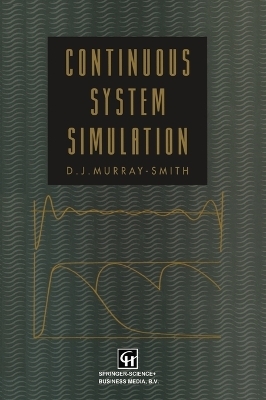
Continuous System Simulation
Chapman and Hall
978-0-412-45150-8 (ISBN)
- Titel ist leider vergriffen;
keine Neuauflage - Artikel merken
This book provides an introduction for students, engineers and scientists to modern methods for computer simulation of systems involving continuous variables. Professor Murray-Smith draws on his many years of experience in teaching and applying continuous system simulation in engineering and biomedical applications to show his readers both the theory and practice of these techniques. His approach is practical throughout, placing particular emphasis on the use of simulation languages and other software tools widely used in the field. A simple simulation language is provided in disc with the book and used with examples and case studies from control, aeronautical and biomedical engineering to give readers hands-on experience. Commercially available software is also described and applied, and model validation and real time simulation techniques and applications are covered in detail. This book should be of interest to engineers and scientists in most processing and manufacturing industry, and most areas of engineering and physical science.
Chapter 1 The Principles of Modelling: 1.1 Objectives in the modelling of systems; 1.2 Continuous-variable and discrete-event models; 1.3 Types of continuous-variable model; 1.4 Modelling and simulation procedures for continuous-variable models. Chapter 2 An Introduction to Simulation Methods: 2.1 The need for simulation; 2.2 Methods of simulation; 2.2.1 Techniques based on special-purpose simulation hardware; 2.2.2 Techniques based on general-purpose computer hardware; 2.3 A review of simulation applications. Chapter 3 Problem Organisation for Continuous System Simulation: 3.1 Introduction; 3.2 Descriptions for continuous-variable models - reduced and state variable forms; 3.3 Conversion from reduced form to state-variable form; 3.4 Transfer function descriptions; 3.5 Bond graph representations; 3.5.1 One-port components; 3.5.2 Causality in bond graph representations; 3.5.3 Junctions in bond graphs; 3.5.4 Coupling between physical domains; 3.5.5 Signals in bond graphs; 3.5.6 Simulation program development from bond graph models; 3.6 Block diagram and signal flow graph representations; 3.7 Block diagram and signal flow graph methods for transfer function simulation; 3.7.1 The direct construction approach; 3.7.2 The parallel construction approach; 3.7.3 The iterative construction approach; 3.7.4 An example of block diagram construction from a transfer function; 3.8 Modelling of distributed parameter elements; 3.8.1 Introduction; 3.8.2 Pure time delay; 3.8.3 Distributed time delay; 3.8.4 Simulation models involving pure and distributed delay elements; 3.9 Parameter sensitivity analysis methods in system modelling and simulation; 3.9.1 Methods for sensitivity cosystem simulation; 3.9.1.1 Parameter sensitivity of linear models; 3.9.1.2 Parameter sensitivity analysis in models containing nonlinear elements; 3.10 Mathematical models of systems having both discrete and continuous elements. Chapter 4 The Principles of Numerical Modelling: 4.1 An introduction to numerical integration methods; 4.2 Fixed-step integration algorithms - one-step methods; 4.2.1 Introduction; 4.2.2 Taylor series descriptions; 4.2.3 Errors in fixed-step integration methods; 4.2.4 Explicit Runge-Kutta methods; 4.2.5 Trapezoidal integration; 4.3 Fixed-step integration algorithms - multi-step methods; 4.4 Problems of integration step size selection and numerical instability; 4.5 Variable-step integration algorithms; 4.6 Problems of "stiff" models; 4.8 Discontinuities and their effects; 4.9 Numerical methods for discontinuous problems; 4.10 Problems of implicit loop structures. Chapter 5 Sampled-Data Models and Operator Methods: 5.1 Introduction; 5.2 Approximations based on sampled-data theory; 5.3 Modelling of linear systems using sampled-data approximations; 5.3.1 Cascaded elements; 5.3.2 Closed-loop systems; 5.4 Modelling of non-linear systems using sampled-data approximations; 5.4.1 Cascaded elements; 5.4.2 Closed-loop models (part contents).
| Zusatzinfo | Illustrations |
|---|---|
| Verlagsort | London |
| Sprache | englisch |
| Gewicht | 840 g |
| Themenwelt | Mathematik / Informatik ► Informatik ► Theorie / Studium |
| Naturwissenschaften ► Physik / Astronomie ► Mechanik | |
| ISBN-10 | 0-412-45150-6 / 0412451506 |
| ISBN-13 | 978-0-412-45150-8 / 9780412451508 |
| Zustand | Neuware |
| Haben Sie eine Frage zum Produkt? |